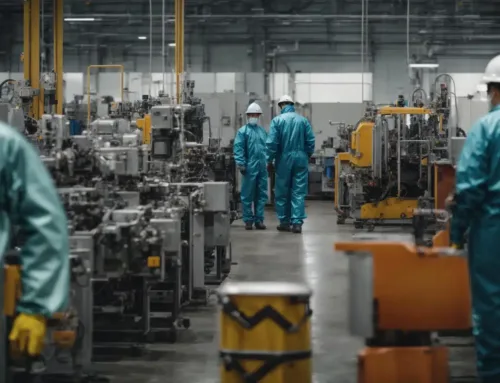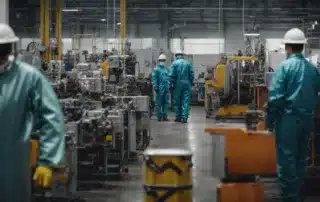Innovative Health Monitoring Devices: The Future of Occupational Health Equipment
Occupational health and safety have become paramount for both employers and employees, necessitating the adoption of innovative health monitoring devices.
These technologies, which include anything from respirator fit testers like Quantifit to dosimeters for radiation detection, are changing the future of workplaces.
They enable health professionals and safety experts to undertake risk assessments effectively – reducing worker exposure to contaminants, managing heat stress, and ensuring louder environments come with sufficient hearing protection.
Keep reading to explore the vital role these devices play in fostering a safer, healthier work environment.
Understanding the Role of Health Monitoring Devices in Occupational Health
A significant player in boosting occupational health and safety is the introduction of innovative health monitoring devices. These include tools such as the NIOSH-approved Quantifit, a respirator fit tester, which ensures the efficacy of personal protective equipment (PPE). Embracing these technologies is mutually beneficial for health professionals and healthcare providers alike, creating a safer work environment and minimizing worker exposure to contaminants, body fluids, and microorganism-induced diseases.
From the perspective of occupational health and safety, assessing and managing various risks, such as heat stress and the presence of hazardous fumes, is a key concern. This is where risk assessment tools, TSI dosimeters, and various safety equipment come into play. Proper use of these tools promotes a strategy for workplace safety that identifies potential health hazards and develops suitable control methods in the work process.
Aside from physical safety, preserving hearing has become a part of occupational health. With devices designed for hearing protection, healthcare workers can now ensure their auditory health in noisy work environments. Significantly, OHD Quantifit, a respirator fit tester, supports proper PPE, including both respirator and eye protection, meeting biosafety level standards set by Occupational Safety and Health Administration.
Occupational health software like McKinsey’s guides health services managers to streamline a protection program that is site content rich. It provides health care facility-specific training courses in varying languages, including español, for easy comprehension by health care workers. Additionally, the software nitrile, extensively used by mine operators, ensures that operations comply with the guidelines of the National Institute for Occupational Safety and Health.
The Breakthrough of Innovative Devices in Occupational Health Management
Innovative health monitoring devices are revolutionizing the landscape of occupational health and safety. Groundbreaking tools like NIOSH-approved Quantifit, a respirator fit tester, and TSI dosimeters have emerged as game-changers. They guard against contaminants, manage worker exposure to body fluids and microorganisms, thereby reinforcing biosafety.
These innovations play a pivotal role in managing and mitigating risks in the work environment, including heat stress and fume exposure. They enable the creation of a comprehensive risk assessment strategy. This, in turn, paves the way for the development of a control method tailored to specific workplace safety issues, including the potential spread of HAIs when handling body fluids.
The surge of advanced equipment within workplace safety has also directed focus towards the auditory health of healthcare workers. Hearing protection devices are increasingly being integrated into the health care facility settings. They are complemented by the likes of the OHD Quantifit respirator fit tester, ensuring the effective use of personal protective equipment such as respirators and eye protection gear to meet biosafety level requirements.
As a part of the ever-evolving technology landscape, software like McKinsey’s occupational health software serves as a comprehensive resource for health services managers. Tools such as these simplify the implementation of a protection program rich in site content, which accommodates the nuances of various healthcare providers, including guidance in various languages like español and tools like nitrile used by mine operators to ensure National Institute for Occupational Safety and Health compliance.
Key Features of Modern Health Monitoring Equipment
Among standout features of modern health monitoring equipment, the precision of tools such as the Quantifit respirator fit tester is notable. It’s an advancement that not only ensures the proper fit of personal protective equipment but also leads to effective guarding against exposure to contaminants and microorganisms in different work environments. It is a product endorsed by authoritative bodies like NIOSH, affirming its excellence in occupational health care.
Tools such as TSI dosimeters and body fluid handling gear are engineered for specific tasks, mitigating harmful circumstances like heat stress and toxic fume inhalation. These equipment are paramount in forming a risk assessment strategy by accurately reading data that help in formulating a site-specific control method. They not only address the immediate hazards but also strive to avoid long-term health risks by limiting worker exposure in the work process.
Another key feature includes acoustic protective devices for hearing protection that cater to noise-heavy environments. They work hand in hand with widely accepted tools like the OHD Quantifit to ensure overall effective use of personal protective equipment. Maintaining biosafety level standards gets easier, and health professionals can confidently administer the care needed without compromising their health.
Further facilitating the occupational health terrain are software solutions like McKinsey’s offerings that ensure managers navigate health services more efficiently. Rich with site content, these tools empower healthcare facilities in delivering training courses in varied languages, including español. Aiding compliance management, they take into account regulations by organizations like the National Institute for Occupational Safety and Health.
Selecting the Right Innovative Health Monitoring Devices
Choosing the right health monitoring device for your needs involves considering several factors. One crucial aspect is the equipment’s compliance with established standards, such as the NIOSH’s approval for a respirator fit tester. This certification ensures that you’re investing in a product that meets rigorous occupational health and safety benchmarks, including quartile performance in contaminant shielding.
Assessing the potential hazards of your work environment is also key in device selection. For example, if workers are exposed to dangerous levels of heat stress or harmful fumes in the workplace, then it would be necessary to opt for a device such as a TSI dosimeter that monitors these factors closely. Additionally, should the work process involve handling potentially infectious body fluids, choosing protective gear and biosafety equipment that guard against microorganisms becomes crucial.
Factoring in specific needs, such as hearing protection in noise-intensive work environments, can also influence device selection. It would be prudent to invest in personal protective equipment like OHD Quantifit that facilitates this protection while also ensuring the suitability and comfort of respirators and eye protection. A biosafety level compliant device is a must for professionals seeking to uphold occupational health standards robustly.
Finally, leaning on modern technologies can significantly simplify the process. With occupational health solutions such as the McKinsey software, managers can effortlessly keep abreast of health care facility requirements. Notably, such software accommodates multilingual workers, offering training course material and risk assessment tools in various languages, including español, thus ensuring comprehensive protection programs that cater to diverse workforces.
The Impact of New Health Equipment on Occupational Health Safety
The advent of innovative health monitoring equipment has had a profound impact on occupational health safety. The introduction of devices like the Quantifit respirator fit tester, certified by NIOSH, raises the effectiveness of personal protective equipment. In turn, this reduces worker exposure to multiple contaminants and microorganisms, ensuring a safer work environment.
In addition to personal safety, these technologies have addressed critical health risks such as heat stress and inhalable fumes within workplaces. TSI dosimeters and other advanced safety equipment make risk assessment more precise and manageable. This ultimately leads to safer work practices and strengthens healthcare workers’ protection while handling body fluids and other potential health hazards.
Furthermore, advanced equipment’s impact extends to specific aspects of occupational health, such as hearing protection. With noise-cancellation devices, healthcare providers can maintain their auditory health, and with the support of tools like OHD Quantifit, personal protective equipment usage becomes more effective. This combination ensures adherence to biosafety level benchmarks, fostering a safe and healthy work environment.
Technological innovations like McKinsey’s occupational health software have revolutionized how health services are managed. Providing training courses in various languages, including español, and streamlining the implementation of protection programs, these software solutions enable health care facilities to meet and even exceed the standards set by the National Institute for Occupational Safety and Health.
Future Prospects of Innovative Health Monitoring Devices
The future of innovative health monitoring devices harbors much promise. Devices like the NIOSH-approved Quantifit resonate with an evolving paradigm in occupational health. With the integration of technology and safety standards, they serve as benchmarks of future advancements aimed at reducing worker exposure to health hazards such as contaminants and body fluids.
With the pressing challenge of managing occupational risks such as heat stress and inhaling harmful fumes, future iterations of TSI dosimeters and similar safety equipment are anticipated. Such equipment will likely be more precise and user-friendly, dedicating more robust data to risk assessment strategies and comprehensive control methods in different work environments.
The evolution of specific protective gear, especially for hearing, initiates a new direction for comprehensive protective measures. Tools like OHD Quantifit, combined with future innovations, will contribute to greater effectiveness and comfort in using personal protective equipment. Amid increasing noise pollution in some work environments, such equipment will enhance worker’s safety, ensuring biosafety level benchmarks are met more easily.
Moving forward, anticipated developments in occupational health software like McKinsey’s will streamline enterprises’ health service management. Rich in meaningful site content, these advancements would offer contextual information to health care providers in multiple languages, such as español. In this progression, health care facilities will be better equipped to adhere to the regulations stipulated by national and international bodies like the National Institute for Occupational Safety and Health.
Conclusion
Innovative health monitoring devices are undoubtedly reshaping occupational health and safety, offering enhanced protection to workers across various sectors.
From NIOSH-approved tools like Quantifit to TSI dosimeters, these sophisticated devices recuperate workplace safety by diligently minimizing exposure to contaminants and body fluids.
They enhance the precision in risk assessment regarding heat stress and harmful fumes, enabling safer work practices.
By focusing on specific safety needs such as hearing protection, these technologies ensure better compliance with biosafety level standards at all workplaces.
Furthermore, advanced occupational health software solutions, such as McKinsey’s, are introducing a more comprehensive and multilingual approach to training and protection program management.
Ultimately, this shift towards innovative health solutions not only strengthens worker safety but also sets the stage for a healthier future in the occupational world.







